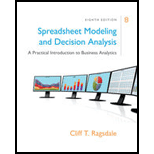
Spreadsheet Modeling & Decision Analysis: A Practical Introduction To Business Analytics, Loose-leaf Version
8th Edition
ISBN: 9781337274852
Author: Ragsdale, Cliff
Publisher: South-Western College Pub
expand_more
expand_more
format_list_bulleted
Concept explainers
Question
error_outline
This textbook solution is under construction.
Students have asked these similar questions
Explain the attributes of an effective corporate leader.
Briefly discuss how corporate governance may enhance corporate social
responsibilities.
Discuss how corporate governance can enhance corporate social responsibilities.
Two ways a workbook can be used in Business Management
Knowledge Booster
Learn more about
Need a deep-dive on the concept behind this application? Look no further. Learn more about this topic, management and related others by exploring similar questions and additional content below.Similar questions
- 6 strategies to encourage a risk aware culture in the workplacearrow_forward3. Critically examine the importance of organisational culture in embedding risk management principles in a business. Suggest strategies to strengthen a risk-aware culture. (20 marks)arrow_forward1. Discuss how the application of PESTEL analysis can assist small businesses in identifying and managing external risks. Provide examples from at least three PESTEL categories. (20 marks)arrow_forward
- . Mention four early warning indicators that a business may be at risk.arrow_forward5. A risk that has both a high impact and high probability is referred to as A. Negligible B. Moderate C. Low D. Extreme 6. A business continuity plan is mainly used to_ A. Increase profits B. Handle daily tasks C. Prepare for disruptions D. Advertise services 7. What is the role of a risk owner? A. To finance the risk B. To monitor and manage a specific risk C. To create risks D. To avoid planning 8. Early warning indicators help businesses to A. Avoid legal actions B. Grow rapidly C. Detect potential risks D. Hire employees 9. A hazard-based risk includes A. Political instability B. Ergonomic issues C. Market demand D. Taxation changesarrow_forward1. What is the primary purpose of risk management in small businesses? A. To eliminate all risks B. To predict profits C. To reduce and control risks D. To create new risks 2. Which of the following is a type of operational risk? A. Interest rate change B. Natural disaster C. Supplier failure D. Tax policy change 3. SWOT analysis identifies all EXCEPT A. Strengths B. Weaknesses C. Tactics D. Opportunities 4. Which strategy involves taking no action against a risk? A. Mitigation B. Avoidance C. Acceptance D. Transferarrow_forward
- 5. A risk that has both a high impact and high probability is referred to as A. Negligible B. Moderate C. Low D. Extreme 6. A business continuity plan is mainly used to_ A. Increase profits B. Handle daily tasks C. Prepare for disruptions D. Advertise services 7. What is the role of a risk owner? A. To finance the risk B. To monitor and manage a specific risk C. To create risks D. To avoid planning 8. Early warning indicators help businesses to A. Avoid legal actions B. Grow rapidly C. Detect potential risks D. Hire employees 9. A hazard-based risk includes A. Political instability B. Ergonomic issues C. Market demand D. Taxation changesarrow_forward1. What is the primary purpose of risk management in small businesses? A. To eliminate all risks B. To predict profits C. To reduce and control risks D. To create new risks 2. Which of the following is a type of operational risk? A. Interest rate change B. Natural disaster C. Supplier failure D. Tax policy change 3. SWOT analysis identifies all EXCEPT A. Strengths B. Weaknesses C. Tactics D. Opportunities 4. Which strategy involves taking no action against a risk? A. Mitigation B. Avoidance C. Acceptance D. Transferarrow_forwardList and briefly describe four risk response strategies.arrow_forward
- Explain the purpose of a risk register.arrow_forwardAssume that your business is going to apply for a bank loan. Step into the shoes of a banking official who has the power to say yes or no to your loan application. From the bank’s vantage point, what are the strengths and weaknesses of your business plan? Does your plan seem realistic, given the financial assumptions and the business environment? What questions would you, as a bank officer, ask about your business plan? As the entrepreneur behind the business plan, how would you answer these questions and persuade the bank to approve your loan? Write up your questions and answers in one paragraph. Then use what you’ve learned to further strengthen your plan.arrow_forwardAssume that your business is going to apply for a bank loan. Step into the shoes of a banking official who has the power to say yes or no to your loan application. From the bank’s vantage point, what are the strengths and weaknesses of your business plan? Does your plan seem realistic, given the financial assumptions and the business environment? What questions would you, as a bank officer, ask about your business plan? As the entrepreneur behind the business plan, how would you answer these questions and persuade the bank to approve your loan? Write up your questions and answers in one paragraph. Then use what you’ve learned to further strengthen your plan.arrow_forward
arrow_back_ios
SEE MORE QUESTIONS
arrow_forward_ios
Recommended textbooks for you
 Practical Management ScienceOperations ManagementISBN:9781337406659Author:WINSTON, Wayne L.Publisher:Cengage,
Practical Management ScienceOperations ManagementISBN:9781337406659Author:WINSTON, Wayne L.Publisher:Cengage, Contemporary MarketingMarketingISBN:9780357033777Author:Louis E. Boone, David L. KurtzPublisher:Cengage LearningMarketingMarketingISBN:9780357033791Author:Pride, William MPublisher:South Western Educational Publishing
Contemporary MarketingMarketingISBN:9780357033777Author:Louis E. Boone, David L. KurtzPublisher:Cengage LearningMarketingMarketingISBN:9780357033791Author:Pride, William MPublisher:South Western Educational Publishing

Practical Management Science
Operations Management
ISBN:9781337406659
Author:WINSTON, Wayne L.
Publisher:Cengage,

Contemporary Marketing
Marketing
ISBN:9780357033777
Author:Louis E. Boone, David L. Kurtz
Publisher:Cengage Learning

Marketing
Marketing
ISBN:9780357033791
Author:Pride, William M
Publisher:South Western Educational Publishing
Single Exponential Smoothing & Weighted Moving Average Time Series Forecasting; Author: Matt Macarty;https://www.youtube.com/watch?v=IjETktmL4Kg;License: Standard YouTube License, CC-BY
Introduction to Forecasting - with Examples; Author: Dr. Bharatendra Rai;https://www.youtube.com/watch?v=98K7AG32qv8;License: Standard Youtube License